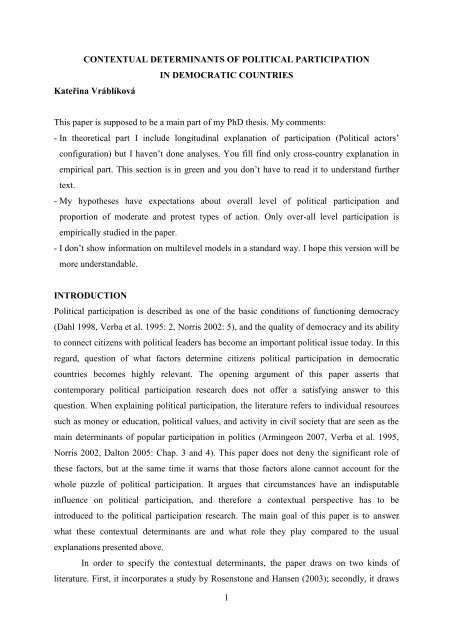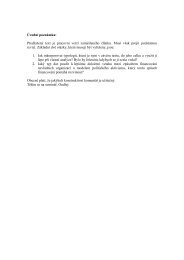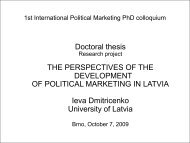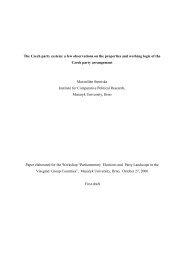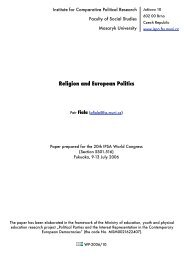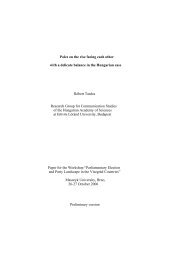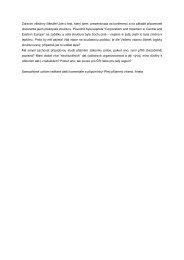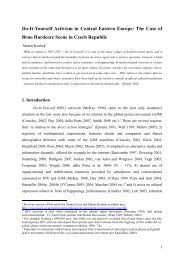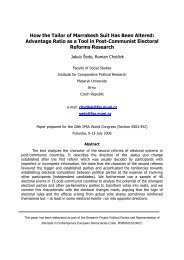CONTEXTUAL DETERMINANTS OF POLITICAL PARTICIPATION
CONTEXTUAL DETERMINANTS OF POLITICAL PARTICIPATION
CONTEXTUAL DETERMINANTS OF POLITICAL PARTICIPATION
You also want an ePaper? Increase the reach of your titles
YUMPU automatically turns print PDFs into web optimized ePapers that Google loves.
on social movement literature, particularly the Political Process Approach that provides aconcept of political opportunity structure (mainly Kriesi et al. 1995, Tarrow 1998, Meyer andMinkoff 2004). On this basis, this paper assumes that the level and the form of politicalparticipation in democracies are affected by institutional design of a respective state,prevailing strategies used by its political elites, and the configuration of political actors.Summed up, this paper tries to answer the question of why citizens of democratic countriesparticipate in politics with reference not only to widely-studied individual characteristics, butalso to the setting of the national political opportunity structure in a given country.The paper will shortly review traditional explanations of political participation first.Then it will introduce contextual theory of political participation that is able to explain bothlongitudinal and cross-country differences in political action and model of politicalparticipation will be presented. The section describing data and methods used will come after.Subsequently the analyses will be presented: first the cross-country differences in politicalparticipation will be displayed and then traditional theories of political participation will betested (section individual level effect). Then bivariate analyses of contextual factors influenceon political participation will be explored. After this examination complete multilevel modelwith contextual effects will be tested.TRADITIONAL EXPLANATION <strong>OF</strong> <strong>POLITICAL</strong> <strong>PARTICIPATION</strong>Why do people participate in politics? Researchers usually study social characteristics andpolitical attitudes that are seen as predispositions of political participation, and involvement insocial networks that implies availability of citizens to the request for participation(Armingeon 2007, Brady et al. 1995, Dalton 2005: Chap. 3 and 4, Norris 2002, Rosenstoneand Hansen 2003, Teorell 2003, Verba et al. 1995).PredispositionsAs many studies have shown, people have to be predisposed to take part in politics (Brady etal. 1995, Verba et al. 1995, Verba et al. 1978, Armingeon 2007, Norris 2002, Rosenstone andHansen 2003). Rosenstone and Hansen (2003) call these factors a personal aspect ofparticipation. Norris (2002) talks about individual level determinants of political participationin this regard. More specifically, there are two types of predispositions related to politicalparticipation. These are individual resources such as education and money on the one handand political attitudes and motivations such as political interest or subjective efficacy on theother hand. Verba, Scholzman and Brady (1995: 16, also Brady et al. 1995: 271) use labels2
These “situations” therefore are exactly what have to become an object of study. Preciselyspeaking, the overall context of political participation has to be taken into account to explainpolitical participation as a whole.Contextual variation in political participation activities other than voting has not yetbeen an object of study (but sees Dalton and van Sicle 2005, Rosenstone and Hansen 2003,applied to political involvement see van Deth and Elff 2004). This perspective has beenapplied only to voter turnout explanation (Blais 2000, Jackman and Miller 1995, Norris 2002)and not to analysis of other forms of political participation like campaigning, taking part indemonstrations, or signing a petition. Exactly this theoretical gap in political participationresearch presents the main focus of this paper.In order to give a contextual explanation of political participation, the paper draws ontwo main sources of ideas. The first one is the work by Rosenstone and Hansen (2003), whoaccounted for variation over time in “governmental” and “electoral” participation in the US,pointing to strategic mobilization of political elites. More importantly, this paper draws on thesocial movement literature as the second source. Authors working within this approach haveintroduced a widely applied tool for the study of social movements/popular contention – theconcept of political opportunity structure (POS).The political opportunities can be defined according to Tarrow (1998:76-77) as“consistent – but not necessarily formal or permanent – dimensions of the politicalenvironment that provide incentives for people to undertake collective action by affectingtheir expectations for success or failure.” A great discussion accompanies this concept. Someauthors criticize its ambiguity or its unsatisfactory application, or question its explanatorypower (Gamson and Meyer 1996: 275, Goodwin and Jasper 2003); others work onclarification of this concept (Kriesi 2004, McAdam 1996, Meyer 2004, Meyer and Minkoff2004, Tarrow 1996).The first ambiguity regarding this concept is what impact the POS has on socialmovement activism resp. political participation. Indeed, one can find contradictory predictionsof protest activities. Some authors expect more protests (e.g. Tarrow 1984) when POS isopen, others (Kriesi et al. 1995) anticipate less of protest actions in open POS. To put itsimply, the reason for this seeming ambiguity is that the influence of political opportunitystructure on political action has a curvilinear form (Eisinger 1973, Tilly 1978). Meyer (2004)points out that the direction of the relationship between open opportunities and protest actiondepends on what part of the curve the researcher is working on and what specific questionss/he wants to answer. In order to overcome this problem, firstly, the domain of the study has5
to be clearly specified. In case of completely closed regimes such as the non-democraticSoviet Union the opening of POS leads undoubtedly to a higher level of protest participation,since no other ways of influence are available to citizens at the time of political opening (seeespecially Tarrow 1998). In contrast, in case of well-established democracies this paperfocuses on, the open political opportunity structure decreases the amount of protest, sinceopportunities are open enough for people to influence politics through low-cost conventional,i.e. non-protest, means rather than by high-cost protest. 1Secondly, Meyer (2004) points out that the majority of social movements‟ studiesconcentrate on the start of political mobilization or on social movements completely excludedfrom the polity. Accordingly, they hypothesize the open political opportunity structure leadsto protest on the part of outsiders, since it is the only repertoire the excluded actors can optfor. Usually, these authors do not see that conventional action forms might be available too orbecome available later on under the conditions of open opportunities. In this case, there is noreason for citizens to rely on costly protest if they can employ low-cost conventional action.The other challenge is designs and measurements usually used for studying politicalopportunity structure. The vast majority of research that uses the POS framework is casestudies that explain the development of one social movement/contentious mobilization in onecountry (Costain 1992, Tarrow 1989, McAdam 1982, Meyer and Minkoff 2004). Thislongitudinal design sees aspects that change over time in one polity, or one policy-issue area,as political opportunity determinants, while keeping the general structure constant. A fewother available studies are concerned with cross-country comparison of social movements orcontentious politics (Kitschelt 1986, Kriesi et al. 1995). They compare overall opportunitystructures across national polities. However, there are very little quantitative studies and nostandard measurement of POS exist.This paper focuses on both types of contextual influence: the longitudinal and crosscaseexplanations. Drawing on social movement literature it considers political actors‟configuration to be responsible for longitudinal variation in political participation and seesnational context design as an account of differences among countries.1 Types of action such as signing a petition belong to low-cost forms; on the contrary, collective protest typessuch as demonstration and violent direct action are the most costly ones (Barnes and Kaase 1979).6
them try to seize the role of “tribunes of the people.” Tarrow theorizes an increase incontentious politics (meaning protest types of action) when these opportunities arise.Meyer and Minkoff (2004) tested the influence of POS on the case of the Americancivil rights movement between 1955 and 1985. Their analysis showed a positive influence ofDemocratic Party advantage in Congress and to Democratic Presidents on the number ofprotest events that were sponsored by US civil rights organizations. Democratic Presidentsand election years were positively correlated with the frequency of creating civil rights socialmovement organizations, whereas contested Congressional elections and electoral instabilityhad a negative effect on it. Unfortunately for this paper, their study did not include number ofparticipants among their dependent variables.Drawing on the reviewed literature, the opening of POS is facilitative for all kinds ofparticipation, either protest or conventional. On the one hand, opportunities open for thoseactors that have been included in political processes and who have now even more openconventional channels to influence politics. The costs of action decrease in these situations sothat they use even more moderate types of action than before. Simultaneously, they also cananticipate success of their pursuit. At the same time, the expanding opportunities also invitethe outsiders and completely excluded groups that are usually studied by social movementscholars (Meyer 2004: 130). Under the conditions of the closed POS these groups havegenerally neither conventional nor unconventional ways of influence available. However, intimes of opening opportunities even these groups see the possibility that their action wouldnot be useless and that someone would pay attention to them when using protest types ofaction.This study will include four dimensions of national political actors‟ configuration:close result, near solutions, instability of political alignments, and possibility of influentialallies. It hypothesizes that the opening of POS in these dimensions will increase overallpolitical participation in both moderate and protest types of action.National contextThe political actors‟ configuration can explain changes in participation over time, in the caseof either moderate or protest types of action. However, the composition of prevailing actionrepertoire, or the proportion of moderate and protest types of action in one country cannot beexplained this way. Furthermore, the configuration of political actors‟ argument cannot fullyexplain political participation in case of cross-country variation (see Kriesi et al. 1995, 2004).8
Individual countries differ not only in who is in power or in the results of elections,but also the overall context in which participation takes place has a significant impact on itslevel. This overall context is deeply rooted in the national polity characterized by specificinstitutional settings and national political culture. Specifically, using the POS framing, thequestion is whether a system is generally open for most of its citizens that they can useconventional strategies and do not have to rely on protest, or whether it is closed that peoplegenerally have no other chance than to use protest types of action. The political actors‟configuration can explain changes in participation over time, in the case of either moderate orprotest types of action. However, the general composition of the usual scale in which thesedifferences occur over time, or the proportion of moderate and protest types of action in onecountry cannot be explained this way.There is no study focused on an explanation of cross-country variation in individuallevel political participation (but see Dalton and Sicle 2005). However, a handful of availablecontentious politics studies concern themselves with a comparison of social movements orcontention politics across national polities (Kitschelt 1986, Kriesi et al. 1995). These studiesdevelop in Tarrow‟s (1996: 43-45) words the “state-centered” perspective on politicalopportunities, which investigates the influence of overall institutional design of a politicalsystem on forms of collective action. A number of authors point out that explanations that areprovided by the political opportunity structure framework are the most suitable for purposesof these cross-national comparisons (Koopmans 1999).This paper draws on work by Kriesi and his collaborators (1995) who studiedcontentious politics in four West European countries (France, Germany, Netherlands, andSwitzerland). To account for the level and the form of social movements‟ activities, theseauthors introduced two conceptual sets of national polity determinants: formal politicalinstitutions and prevailing strategies (Kriesi et al. 1995, for review see Kriesi 1999).Political institutionsRegarding political institutions, Kriesi et al. (1995) claimed that the openness of the politicalsystem is a function of the state‟s strength that “implies a multiplication of state actors and,therefore, of points of access and decision making” (Kriesi et al. 1995: 28). The authorsdistinguish between weak and strong states, explaining that weak states that do notconcentrate power in one center are characterized by a greater degree of formal access and amore limited capacity to act (Kriesi et al. 1995: 25). This environment creates a facilitativeeffect as more access points connote a higher number of possible channels to influence9
politics, and lowers state capacity to act, so that the costs for political participation decrease(Kriesi et al. 1995: 41). As a result, this design encourages a higher level of political actionand will facilitate more moderate types of action that are low-cost. At the same time, thanks toinstitutionally ensured channels of engagement participation is likely to be successful.On the contrary, in a strong state, activists face a powerful centralized authority thathas a high capacity to act and channels for involvement are not institutionalized (Kriesi et al.1995: 45). This situation largely increases the costs of political participation that leads to alow overall level of political participation and citizens will have to use more costly strategiesto affect politics, which means protest types of action. The chances of success are also low, asthe state usually has enough capacity to deal with challengers.Kriesi and his collaborators‟ analysis actually shows that weak states such asSwitzerland experienced a higher level of moderate types of action such as signing a petitionor taking part in a campaign, and a lower level of protest types like taking part in ademonstration or a strike. The case that represents a strong state in their sample is France thatdisplays the lowest overall level of mobilization and the highest portion of protest types ofaction (Kriesi et al. 1995: 45). On this basis we can hypothesize the influence that the strengthof the state will have on individual political participation.The institutional design hypotheses:The weaker an state is, the higher the overall level of political participation.The weaker an state is, the more moderate types of political participation and the lower thelevel of protest types of political participation.Prevailing StrategiesAs pointed out above, Kriesi et al. (1995) take into account also cultural aspect of politicalopportunity structure that they study under the notion of prevailing strategies. Some authorscriticized the original studies of POS that emphasized the formal institutional design andoverlooked a cultural dimension of the environment (Goodwing and Jasper 1999). They arguethat not only institutional (formal) opportunities are important for contentious politics, butalso cultural circumstances such as existing culture beliefs and practices matter.Kriesi and his colleagues‟ concept of prevailing strategies reflects the dominantcultural model of “procedures that members of the political system employ when they aredealing with challengers” (Kriesi et al. 1995: 33). They distinguish between states thatemploy exclusive strategies, which are confrontational and polarizing, and states that utilize10
integrative procedures, which are facilitative, cooperative and rely on integrative strategies(Kriesi et al. 1995: 33-34). Inclusive strategies lead to a higher overall level of mobilizationand more moderate types of action as confirmed in the case of Switzerland. They explain thatintegrative regimes have a facilitative effect, as they rely more on cooperation with non-stateactors or even subsidize the non-governmental sector, and are friendly to public engagement(Kriesi et al. 1995: 41). The costs of participation are lowered this way, as informal channelsfor participation are open and engagement is welcomed. At the same time, inclusive statessend a message that they are ready to respond to citizens‟ demands that are expressed by theiraction. The success chances are thus high in inclusive regimes. This high likelihood ofsuccess increases the overall level of mobilization and leads to more moderate action.Exclusive strategies, on the other hand, imply lower level of mobilization in generaland a higher level of protest types of action which is represented by France in their analysis.The reason is that exclusive states do not facilitate a high level of citizens‟ engagement inpolitics. They do not support people getting involved in politics and do not provide them withproper channels to take part. In this situation, when people can not anticipate positivereactions from the political system, the costs of participation are much higher than in inclusivestates, as citizen engagement is not enabled by the political regime. As a result, citizensparticipate less than in inclusive states and only implement more costly protest forms ofaction (like demonstrations) to have their voices heard. Additionally, success is unlikely inexclusive states, as political elites do not “care about” policy projects coming from the outsideof the state. To be successful, activists‟ goals have to be forced on to the regime by (morecostly) protest types of action, as other means are neither available nor effective. 2On this basis, the presupposed influence of prevailing strategies on politicalparticipation can be derived.The more integrative a state is, the higher the overall level of political participation will be.The more integrative a state is the more moderate and the lower the level of protest types ofpolitical participation will occur.2 Kriese et al. (1995) claim that both factors – strength of the state and prevailing strategies – have todisplay the same values to imply the highest/lowest level of mobilization and the highest level ofmoderate/protest types of action, as in the cases of weak and inclusive Switzerland and strong andexclusive France. The middle values of mobilization are expected when high level of one determinantis combined with low level of the second one. This influence is shown on the cases of Netherlands andGermany, which present a strong and inclusive state on one hand, and a weak and exclusive state onthe other hand, and display levels of mobilization positioned between Switzerland and France (Kriesiet al. 1995: 77).11
The overall model of political participation that takes into account circumstances ofpolitical participation is summarized in Figure 1. Firstly, it expects that the variation inpolitical participation over time is caused by configuration of political actors. Secondly, itexpects that the differences among countries in political participation are due to nationalcontextual characteristics (institutional design and prevailing strategies) that are deeply rootedin respective societies. At the same time the model incorporates also traditional explanationsof political participation.Figure 1: Model of Political ParticipationDATA AND METHODSThis theoretical model of political participation, which includes more levels of explanation,requires multi-level design and appropriate statistical techniques. Hence multilevel modelingwill be used in this paper. Multilevel approach expects that there are hierarchical effectsinfluencing first level phenomenon (see Hox 2002, Kreft and Leeuw 2006). Specifically inthis study, the outcome and traditional factors influencing political participation measured aremeasure at the individual level of respondents (first level). At the same time the individualsare nested in countries that are characterized by contextual factors (second level) that shouldinfluence political participation of individuals. Multilevel modeling using HLM6 will beemployed here since it is able to analyze multi-level data.The individual level data come from international individual survey ISSP 2004. Thenumber of included countries is 23. The county-level characteristics measuring politicalopportunity structure were supplemented into this data set. The Democracy Time-series Datadatabase was used for Fiscal decentralization and Effective number of parties (see Norris2008). Political Constraints indicator comes from POLCON Database (see Henisz 2002).Corporateness was coded according to Jepperson (2002).12
ANALYSESThis research defines political participation according to Teorell et al. (2007: 336) andRosenstone and Hansen (2003: 4) as “every action of ordinary citizens directed towardinfluencing some political outcomes: distribution of social goods and norms.” Drawing onthis definition various types of activities fall under political participation from attendingdemonstration, over boycotting to contacting politicians. Although voting also belongs topolitical participation according to this definition, this paper will not include this type ofactivity since it is inherently different from all of the other types of political participation andit is supposed to have different structural-level determinants (Blais 2000, Jackman and Miller1995, Norris 2002). Graph 1 presents a basic description of political participation in NorthAmerican and European democracies under study. Specifically it shows mean of Politicalparticipation index made of eight activities covered by ISSP 2004.Graph 1: Political participation in western democraciesSource: ISSP 2004.Mean of Political participation index (min=0, max=1). Additive index of 8 activities undertaken in theprevious 12 months.As we can see the difference in average political participation across countries is nottrivial. The Swiss that score on the highest level of political participation (0,2) are ten timesmore active than the least engaged Bulgarians (0,02). We can see that post-communistcountries together with Portugal belong to group of countries with lowest average level ofpolitical participation. United Kingdom, Ireland, Finland and Spain seem to be second group13
most. 3 Model 3 tests the whole traditional model including predispositions and mobilizingof countries whose citizens engage in politics not so much. Citizens of other old democraciesparticipate in politics on average more with USA, Austria, France, Canada and Switzerland atthe top.Traditional model of political participation (Individual level effects)Previous section indicated that there is a difference among countries in political participation.This notion is statistically supported by the Intra-class Correlation Coefficient (ICC) of 13 %displayed at the bottom of table 1. The ICC figures a proportion of variance in politicalparticipation accounted for by country membership (Kreft and Leeuw 2006). Simply said, itclearly shows that the national level explanation of political participation cannot beoverlooked since some variation in political participation is caused by the national levelfactors.Model 1, 2 and 3 displayed at the table 1 tests predispositions (resources and attitudes)and mobilizing channel. These models are already multi-level ones since they control forvariation at the country level, however only individual level factors are introduced into theanalysis. Since this paper is not primarily interested in individual level explanation theinterpretation will focus only on influential factors that matter for political participation thechannels factors. Model 3 Betas indicating the power of individual explanatory factors showthat membership in social groups and political discussion are the strongest explanatoryfactors. The relationship between political participation and both indicators of mobilizingchannels is positive which means that more “channels” lead to more participation. Regardingpredispositions, the most influential political attitude factor is unsurprisingly interest inpolitics. People who are more interested in politics also tend to participate more in politics.Age included in resources is the last influential factor. We can see that the relationship isnegative which means that younger people participate more in politics. The other factors thatshould effect political participation according to traditional theory are significant but not aspowerful as the four above mentioned. Regarding the explained variance the traditional modelwas able to account for 16 percent of variation at the individual level and at the same time3 The second reason why the interpretation will focus on the explanatory power of individual independentvariables is also that all of the introduced factors are significant thanks to the large number of cases included inthe analysis. In this situation even very weak effects appear to be significant but do not add much to theexplained variance. From this reason also Beta coefficients will be interpreted since they describe explanatorypower of individual factors included in a respective model.14
managed to decrease unexplained variation at the national level as well (38 %). It seems thatsome of the individual level factors also vary cross-nationally.Table 1: Predispositions, Mobilizing channels and political participationModel 0 Model 1 Model 2 Model 3variables B B Beta B Beta B Betaintercept 0,115 0,119 0,110 0,102PREDISPOSITIONSSESwoman -0,003 -0,010 0,012 0,036 0,018 0,054ISCO -0,001 -0,180 -0,001 -0,105 -0,001 -0,060Years of Education 0,001 0,057 0,001 0,049 0,001 0,048Age -0,001 -0,063 -0,001 -0,095 -0,001 -0,095MOTIVATIONSCitizen Duty 0,016 0,088 0,010 0,055External Efficacy 0,010 0,063 0,006 0,042Social Trust 0,019 0,084 0,014 0,060Political Interest 0,042 0,212 0,021 0,106Internal Efficacy 0,015 0,097 0,011 0,067political trust 0,008 0,043 0,008 0,042MOBILIZING CHANNELSGroup membership 0,061 0,264Political discussions 0,031 0,154Unexplained variance 1 st level 86,8%Explained variance 1 st level 3,2% 7,7% 16,1%Unexplained variance 2 nd level 13,2%Explained variance at 2 nd level 14,0% 41,5% 62,8%Total explained variance 0% 4,6% 12,2% 22,3%Significance is not displayed since all factors and error terms are significant at p ˂ 0,001.Bivariate Analysis of Contextual EffectThe analyses presented above showed the effect of individual level factors on politicalparticipation controlling for the country level. About a half of country level variance remainsunexplained and possible country differences in the effect that individual level factors canhave on political participation have not been explored. As stated in the theoretical part of thepaper this study will try to find contextual explanation in political opportunity structureframework. Regarding national context the institutional design and prevailing strategies havebeen introduced as the main dimensions of national political opportunity structure.Institutional design refers to multiplication of state actors and therefore is related to the degreeof formal access and the capacity of the state to act (see above). Kriesi et al. (1995: 28) claim15
that strength of the state is a function of two factors: territorial centralization and horizontalseparation of power that includes separation among powers and separation within powers.Institutional Design - Territorial CentralizationTerritorial decentralization is generally seen as transfer of power, resources and decisionmakingfrom the central government to local and regional authorities (Schneider 2003: 33,Kriesi et al. 1995: 28). Political opportunity structure proponents suppose that with growingterritorial decentralization the number of access points for political action increases and hencewe can expect more popular mobilization in decentralized polities.Common way to measure territorial centralization is to distinguished between federaland unitary states. However, as some authors have shown (e.g. Norris 2008), these twocategories do not precisely indicate the level of decision-making decentralization sincedramatic differences exist within the two groups in power that the local political authoritiesactually have. Hence more sophisticated measure of territorial decentralization are needed.Schneider (2003) developed a measure of three related but separate dimensions ofdecentralization: fiscal, administrative and political decentralization. This article uses fiscaldecentralization that indicates the share of subnational expenditures and revenues based ondata from IMF/WB (Schneider 2003: 36). This measure meets the purpose of what is meantby territorial decentralization the most since it measures actual power the local and regionalauthorities have. The stronger a state is, the more centralized it is; this in turn means that localand regional authorities distribute less money. 4Figure 2 displays a relation between fiscal decentralization of a state and politicalparticipation. As we can see, the relationship is positive, quit strong, and linear. The cases ofRussia and France seem to be outliers. If these cases are deleted from the analysis, therelationship is even stronger (explained variance increases to 0,66). Generally, our hypothesisseems to be supported for now: the higher decentralization of a state the higher overall levelof political participation. In other words, weaker states in the sense of vertical centralizationimply higher citizens activity in politics.4 The values of Fiscal Decentralizations are factor scores based on confirmatory facotr analysis and standardizedto range from 0 to 1.0 (see Schneider 2003).16
Graph 2: Political participation and Fiscal DecentralizationInstitutional Design - Horizontal Separation of PowersSeparation of powers refers to horizontal de/centralization of the state. The number of accesspoints and capacity to act is indicated by the level of separation of power among parliament,the executive, and the judiciary and by separation of powers within each of these branches(Kriesi et al. 1995: 28-29).Separation of powers is usually classified into three types of systems: parliamentarism,presidentialism and semipresidentialism. However, like in case of federalism-unitary statetypology, this classification is criticized that it is not able to detect actual separation of poweramong individual state bodies (e.g. Norris 2008, Elgie 1996, Tsebelis 1995). Moreover thereis not much variation among democratic countries using this simple three-categoryclassification. This research has to use more detailed measures of power separation that is ableto capture number of more or less independent power centers at the horizontal level of a state.For these purposes quit a large number of scales and indexes measuring various aspects ofpresidentialism and parliamentarism can be used. This paper makes use of Political Constraintindicator that measures separation of powers in more detail (Henisz 2000). Henisz‟s indicatorcaptures both formal and effective separation of powers within a political system. It isconstrued by number of independent veto points in the system and measures also effective17
power of these points that is dependent on actual political affiliation of specific actors in thesepositions (Henisz 2000: 5).Figure 2 displays a relation between political participation and horizontal separationamong powers measured by Political Constraints indicator. As we can see, Russia is anextreme case that strongly raises the linear relationship and the effect of political constraintson citizen participation in politics. Still, even when Russia is excluded the positiverelationship remains. Generally, the expected influence of higher number of independentpower centers in political system on overall level of political participation seems to besupported. There is evident positive relationship between horizontal powers separation andlevel of citizens activity in politics. What is striking is that as in the case of territorialcentralization the effect of political opportunity structure on political participation seems to belinear. Somewhat surprisingly there is not some value of political opportunity structureopenness in which political participation would stop further increasing.Graph 3: Political participation and Separation among Powers (Political Constraint)Institutional Design - Separation within PowersRegarding separation of powers within the executive and parliament, political parties shouldplay the crucial role in explaining social movements‟ mobilization (Kitshelt 1986, Kriesi et al.1995: 29). A higher number of parties in parliament means a higher number of access pointsto the political system. The effective number of parties can be used as an indicator of18
parliamentary separation of powers (van Deth and Elf 2001, in relation to social movements,see Özler 2008). Among other political system characteristics, the number of parties is relatedto government formation. According to Kriesi et al. (1995: 30), the separation of powerswithin government is indicated by the combination of two factors, i.e. the number of parties ingovernment and the level of party discipline. Unfortunately I haven’t managed to collect thesedata, hence only effective number of parties that should imply more access points in theparliament will be analyzed.As displayed in graph 3 the separation within powers does not influence overallpolitical participation very much. Effective number of parties has very weak or nonexistenteffect on political participation. Contrary to horizontal and vertical separation of stateinstitutions presented above, the number of targets that are available in parliament for politicalaction does not make people participate more or less in politics.Graph 4: Political Participation and Effective number of partiesPrevailing strategiesKriesi et al. (1995) describe prevailing strategies as dominant procedures that are used bypolitical elites when they are dealing with opponents. This concept is the least clear and Kriesiet al. do not provide a precise definition. The prevailing procedures of the state can be seenalso as the strategies used when the state deals with civil society, various associations andvoluntary actions of citizens etc. In this respect, indicators such as the level of corporatism,19
strength of trade unions, or portion of state budget designed for the support of the civil societyorganizations can be taken into consideration. Van Deth and Elff (2001) measure “structure ofinterest mediation” by summary indicator composed by Lijphart‟s index of interest grouppluralism/corporatism and Lane and Erssons‟s Consociationism and Corporatism indexes.Although these indicators are widely used to indicate corporatism or interest representationthey cannot be used in this analysis since the post-communist countries have not beenincluded in the measurement.This study applies strategy of Schofer and Fourcade-Gourinchas (2001) who study“corporateness”, developed by Jepperson‟s (2002), to account for cross-country variation inassociational membership. Drawing on historical difference in state consolidation paths,Jepperson distinguishes between corporate and non-corporate states (called associationalsocieties). Simply said, in the first group of countries corporate structures (based on class,occupation etc.) have remained and social life is based on these organized groups andcollectives. In the second group of polities corporate structures were weakened and moreintegrated societies based on individualism rather than on collectivities emerged (Jepperson2002: 65). According to Schofer and Fourcade-Gourinchas (2001: 813-814), in corporatecountries a state supports collective actors and corporate structures work as intermediaryinstitutions that encourage social participation.When we look at graph four we can see rather opposite results in case of politicalparticipation. Corporateness seems to be connected with lower political participation. Possibleproblem is that all of the post-communist countries together fall into the category of corporatestates and at the same time show low political participation. If post-communist countries areexcluded the relation between corporateness and participation is opposite and weaker.20
Graph 5: Political participation and CorporatenessMultilevel Explanation of Political ParticipationAggregate level bivariate analysis presented above has shown relationship between politicalparticipation and contextual factors. Drawing on this analysis, territorial centralization,separation among powers and prevailing strategies matter for citizens activity in politics. Asregards institutional setting design, both indicators fiscal decentralization and politicalconstraints have positive effect on the level of political participation as expected by the theorythat hypothesizes higher level of citizens political engagement with more open politicalopportunities structures. Different results were shown for prevailing strategies. In this case thebivariate analysis showed opposite effect of state inclusiveness than the theory expected. Onaverage countries with high corporateness system score lower on political participation indexthan countries with low corporateness. Finally, separation within powers, namely number oftarget points in the parliament, did not seem to play much role for political participation.Table 2 displays multi-level linear regression that includes together with abovepresented individual level factors also the contextual determinants. The continuous factorswere introduced into the analysis as grand-centered (mean equal to zero). The intercept is thena grand mean indicating average political participation from the total sample for people whoscore average values on the independent factors.From model 4 to model 6 three contextual factors are introduced into the analysis oneby one. We can see that fiscal decentralization matters for individual level political21
participation even though influential individual level factors are controlled. Fiscaldecentralization is quite strong factor that achieves Beta coefficient value similar to otherexplanatory variables. It is positive which means that political participation is higher incountries that are more decentralized. The very same interpretation holds for politicalconstraints. It actually matters for political participation and has expected direction: the morepolitical constraints, i.e. independent veto players, the more political participation whencontrolling for predispositions and mobilizing channels. The effect of corporateness is alsosignificant. However, it is weaker and contrary to theory negative. People with average age,average political interest and average involvement in mobilizing channels participate more inpolitics in non-corporate states than in corporate ones. This result should be treated in cautionsince it is not sure what this indicator actually measures (see above). For further analysis itwill not be included. Another reason is that it will help general reliability of the model sincethe number of countries is low and the number of possible explanatory factors is limited.After the examination of the direct effect that the political opportunities structure hason political participation the random slope of the most influential individual level factors –mobilizing channels – was explored. Tests of random slopes for group membership andpolitical discussion, which means that the effects of these factors can vary among countries,were significant. In other words, it means that effect of mobilizing channels on politicalparticipation is stronger in some countries than in others. The question is why. Drawing onsocial movement theory, we can expect that POS can be the national characteristic thatinfluences the effect of mobilizing channels. As mentioned in theoretical discussion, socialmovements and other mobilizing agencies such as politicians or friends are supposed tomobilize individuals into political action. POS theory was primarily developed just for thistype of actors, specifically social movements, and drawing on it we should expect thesemobilizing agents to act according to the openness of political opportunity structure also.Of course, we cannot test the effect of mobilizing agents behavior since we do notmeasure it. However we manage to measure mobilizing channels that are employed forpopular mobilization according to the theory. Model 7 brings the results. With theintroduction of random slopes and interaction effects, the model tests the common influenceof contextual and individual level factors on the outcome. It also examines the effect ofcontextual factors on the random slope of the individual level explanatory variables. Simplysaid, we can say how much the national level factor accounts for varied effect of specificindividual level independent variable.22
Table 2: Multilevel model of political participationModel 4 Model 5 Model 6 Model 7variables B Beta B Beta B Beta B Betaintercept 0,110 0,110 0,130 0,121PREDISPOSITIONSSESAge -0,001 -0,110 -0,001 -0,110 -0,001 -0,110 -0,001 -0,106MotivationsPolitical Interest 0,026 0,130 0,026 0,130 0,026 0,130 0,025 0,129MOBILIZING CHANNELSGroup membership 0,066 0,283 0,066 0,283 0,066 0,282 0,061 0,262Political discussions 0,033 0,162 0,033 0,162 0,033 0,162 0,034 0,171<strong>CONTEXTUAL</strong> EFFECTSFiscal Decentralization 0,093 0,110 0, 101 0,119 0,100 0,118 0,105 0,123Political Constraints 0,145 0,111 0,143 0,108 0,109 0,083Corporateness -0,030 -0,086CROSS-LEVEL EFFECTSMembership*Fiscal Decent. 0,042 0,156Pol. Discussion* Fiscal Decent. 0,068 0,267Pol. Discussion *Pol. Constraints 0,081 0,242Explained variance 1 st level 19,7% 19,7% 19,7% 21,8%Explained variance at 2 nd level 70,9% 76,3% 81,9% 73,6%Expl. var. random slope discussion 69%Expl. var. random slope membership 52,4%Total explained variance 26,5% 27,2% 28,0% 30,6%Significance is not displayed since all factors and error terms are significant at p ˂ 0,05.Section Cross-level effects in Table 2 displays significant interaction effects ofmobilizing channels indicators and institutional design factors (Appendix shows these effectsgraphically). As we can see, all of Beta coefficients for these interactions are really strong andpositive. Specifically, the effect of membership in groups and associations grows with fiscaldecentralization of a country. In other words, involvement in civil society groups plays abigger role for political participation if someone lives in a country characterized by verticaldecentralization than in centralized one. As shown in row Explained variance for randomslope membership, the fiscal decentralization is responsible for 50 percent of membershipeffect variation among countries. Regarding group membership, the horizontal separationamong powers did not have a significant effect on its random slope.In case of political discussion we can see significant interaction effects with bothinstitutional design indicators. Political discussion leads to more political participation inmore decentralized countries as well as in countries with more political constraints. In other23
words, for people with average age and political interest, political discussion brings differentresults (more political participation) in more decentralized countries with more veto players athorizontal level than in centralized countries. Moreover, these two POS indicators managed toexplain over 75 percents of political discussion random slope variance among countries.The other important finding is that contextual factors keep their significance and stillmatter for political participation although interaction effects are introduced. It means thatpolitical opportunity structure has its independent direct effect on political participation anddoes not happen only through mobilizing channels as displayed in theoretical model (figure1).CONCLUSIONSThe goal of this paper was to present more complete theory of political participation thatwould incorporate contextual perspective. The paper demonstrated that political context has tobe taken into account not only from theoretical reasons but also because of empirical findingsshowing that country level variation in individual political participation exists. Together withtraditional explanations such as predispositions and mobilizing channels the contextual theoryof political participation was presented. Drawing mainly on social movement theory and itsconcept of political opportunity structure longitudinal determinants of political participationcalled Political actors‟ configuration and cross-country explanatory factors called Nationalcontext were introduced. The paper then focused on National context that was divided atconceptual level according to Kriesi et al. (1995) into Institutional Design and Prevailingstrategies. The theory expected openness of political opportunity structures in both of thesedimensions to increase overall level of political participation.After the descriptive part, test of traditional model of political participation andaggregate level bivariate analyses, the full multilevel model of political participation wastested. The analysis showed that type of polity where one lives matters for his/her politicalparticipation. Both dimensions of National context Institutional design and Prevailingstrategies significantly increase political participation. Specifically, with growing territorialdecentralization and growing horizontal separation among powers (Institutional design) and incorporate countries (Prevailing strategies) people participate more in politics. Moreover, theanalysis showed that Institutional design characteristics influence the individual levelexplanatory variables included as mobilizing channels. Specifically, higher involvement inmobilizing channels has a higher influence on political participation if someone lives in acountry with more open political opportunity structure (more decentralized and more24
horizontal veto players). In other words, these networks such as membership in associationsor political discussions work differently in various contexts. This finding could point at adifferent role that mobilizing agents such as social movements and other actors play indifferent institutional settings. In open political opportunity settings the mobilizing channelsare employed by the mobilizing agents more to mobilize people than in less open structures.LITERATUREArmingeon, K. 2007. “Political Participation and Associational Involvement“. In: Citizenship andInvolvement In European Democracies. A Comparative Analysis. Eds. van Deth, J. W, Montero, J.R. a Westholm, A. London, New York: Routledge, 358-384.Barnes, S. H. a Kaase, M., eds. 1979. Political Action: Mass Participation in Five WesternDemocracies. Thousand Oaks, CA: Sage.Blais, A. 2000. To Vote or Note To Vote? The Merits and Limits of Rational Choice Theory.Pittsburgh, PA: University of Pittsburgh Press.Brady, H. E., Verba, S. a Scholzman K. L. 1995. “Beyond Ses: A Resource Model of PoliticalParticipation“. The American Political Science Review, 89(2): 271-294.Costain, A. N. 1992. Inviting Women’s Rebellion: A Political Interpretation of the Women'sMovement. Baltimore: The Johns Hopkins University Press.Dalton, R. J. 2004. Democratic Challenges, Democratic Choices: the Erosion of Political Support inAdvanced Industrial Democracies. Oxford, New York: Oxford University Press.Dalton, R. J. 2005. Citizen Politics: Public Opinion And Political Parties In Advanced IndustrialDemocracies. Washington: CQ Press.Dalton, R. J. 2008. “Citizenship Norms and the Expansion of Political Participation.” Political Studies,56: 76-98.Dalton, R. J. and Sicle, A. 2005. “The Resources, Structural, and Cultural Bases of Protest.” Paperpublished in the Center for the Study of Democracy research series.Eisinger, Peter K. 1973. “The Conditions of Protest Behavior in American Cities.“ The AmericanPolitical Science Review, 67: 11–28.Goodwing, J. and Jasper, R. A. 1999. “Caught in a Winding, Snarling Vine: The Structural Bias ofPolitical Process Theory.” Sociological Forum, 14(1): 27-92.Henisz, W. 2000. “The Institutional environment for growth.” Economics and Politics, 12: 1-32.Jackman, R. and Miller, R. A. 1995. “Voter Turnout in the Industrial Democracies During the 1980s.“Comparative Political Studies, 27: 467-492.Kitschelt, H. P. 1986. “Political opportunity Structures and Political Protest: Anti-Nuclear Movementsin Four Democracies,” British Journal of Political Science, 16(1): 57-86.25
Koopmans, R. 1999. “Political. Opportunity. Structure. Some Splitting to Balance the Lumping.”Sociological Forum, 14(1): 93-105.Kriesi, Hanspeter. 2004. “Political Context and Opportunity.” In The Blackwell Companion to SocialMovements, eds. David Snow, Sarah Soule a Hanspeter Kriesi. Malden, Oxford, Carlton: BlackwellPublishing, s. 67-90.Kriesi, H., Koopmans, R. and J. W. Duyvendak. 1995. New Social Movements in Western Europe: aComparative Analysis. London: UCL Press.Kriesi, H. and Westholm, A. 2007. “Small-scale Democracy: the Determinants of Action“. In:Citizenship and Involvement In European Democracies. A Comparative Analysis. Eds. van Deth, J.W, Montero, J. R. a Westholm, A. London, New York: Routledge, 221-254.Kreft, I. and Leeuw, J. D. 2006. Introducing Multilevel Modeling. London: Sage.Luke, A. D. 2004. Multilevel Modeling. Thousand Oaks: Sage.McAdam, D. 1998. Political Process and the Development of Black Insurgency, 1930-1970. Chicago:University of Chicago Press.McAdam, Doug. 1996. “Conceptual Origins, Current Problems, Future Directions.” Pp. 23-37 inComparative Perspectives on Social Movements. Political Opportunities, Mobilizing Structures,and Cultural Framings, edited by Doug McAdam, John McCarthy, and Mayer N. Zald.Cambridge: Cambridge University Press.Meyer, D. 2004. “Protest and Political Opportunities.” Annual Review of Sociology, 30: 125-145.Meyer, D. S. and Minkoff, D. C. 2004. “Conceptualizing Political Opportunity.” Social Forces,82(4):1457-1492.Norris, P. 2002. Democratic Phoenix: Reinventing Political Activism. New York: CambridgeUniversity Press.Norris, P. 2008. Driving Democracy: Do power-sharing institutions work? New York, Cambridge:Cambridge University Press.Özler, S. I. 2008. “The Relationship between Political Party System and Social Movements: A Test ofthe Political Opportunity Structure.” Paper presented at the annual meeting of the WESTERN<strong>POLITICAL</strong> SCIENCE ASSOCIATION, Manchester Hyatt, San Diego, California, USA.Pattie, C. a Seyd, P. 2003. “Citizenship and Civic Engagement: Attitudes and Behavior in Britain.“Political Studies, 51: 443–468.Putnam, R. D. 1995. “Bowling Alone: America‟s Declining Social Capital.“Journal of Democracy, 6: (1) 65-78.Rosenstone, S. J a Hansen, J. M. 2003. Mobilization, Participation, and Democracy in America. NewYork: Longman.Snow, D. A., E. B. Rochford, Worden S. K and Benford R. D. 1986. “Frame Alignment Processes,Micromobilization, and Movement Participation.” American Sociological Review, 51: 464-481.26
Snow, D. A. and Benford, R. D. 2000. “Framing Processes and Social Movements: An Overview andAssessment.” Annual Review of Sociology, 26: 611-639.Schneider, A. 2002. “Decentralization: Conceptualization and Measurement.” Studies in ComparativeInternational Development, 38(30): 32-56.Schofer, E. and Fourcade-Gourinchas, M. 2001. “The Structural Contexts of Civic Engagement:Voluntary Association Membership in Comparative Perspective.“ American Sociological Review,66(6): 806-828.Stolle, D. 2007. “Social Capital.” In: The Oxford Handbook of Political Behavior. Eds. Dalton, R. J. aKlingemann, H. D. Oxford University Press: Oxford, 655-675.Tarrow, S. 1998. Power in Movement: Social Movements and Contentious Politics. Cambridge:Cambridge University Press.Tarrow. S. 1996. States and Opportunities: The Political Structuring of Social Movements. InMcAdam, D., McCarthy, J. D., Zald, N. M. (eds.), Comparative Perspectives on Social Movements.Political Opportunities, Mobilizing Structures, and Cultural Framings. Cambridge UniversityPress.Teorell, J. 2003. “Linking Social Capital to Political Participation: Voluntary Associations andNetwork of Recruitment in Sweden.“ Scandinavian Political Studies, 26(1): 49-66.Teorell, J., Torcal, M and Montero J. R. 2007. “Political Participation: Mapping the Terrain.“ In:Citizenship and Involvement In European Democracies. A Comparative Analysis. Eds. van Deth, J.W, Montero, J. R. a Westholm, A. London, New York: Routledge, 334-358.Thomassen, J. a van Deth, J. 1998. “Political Involvement and Democratic Attitudes.“ In: ThePostcommunist Citizen. Eds. Barnes, S. H. a Simon, J. Budapest: Erasmus Foundation, 135-165.van Deth, J. W. and Elff, M. 2001. Politicisation and political interest in Europe: A multilevelapproach. Mannheim: Mannheimer Zentrum für Europäische Sozialforschung (MZES WorkingPaper 36).van Deth, J. W. and Elff, M. 2004. “Politicisation, economic development and political interest inEurope“. European Journal of Political Research, 43: 477–508.van Deth, J. W., Montero, R. J. and A. Westholm (eds.) 2007. Citizenship and involvement inEuropean Democracies: a Comparative Analysis. New York: Routledge.Verba, S., Scholzman, K. L. and H. Brady. 1995. Voice and Equality: Civic Voluntarism in Americanpolitics. Cambridge: Harvard University Press.27
APPENDIXGraph 1: Varied effect of Group membership on Political Participation in 3 groups ofCountries by Fiscal decentralizationGraph 2: Varied effect of Political discussion on Political Participation in 3 groups ofcountries by Political ConstraintsGraph 1: Varied effect of Political discussion on Political Participation in 3 groups ofCountries by Fiscal decentralization28


